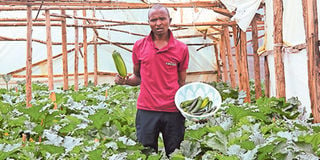Student ploughs courgette profits

Lucas Mutua harvests courgettes that he grows in Kamulu, along Kangundo Road. Courgettes are best eaten fresh and they can also be stored in the fridge for a few days. PHOTO | LEOPOLD OBI | NMG
What you need to know:
- A final year student at Jomo Kenyatta University of Agriculture and Technology, Mutua went into farming about three months “by accident”, he says.
- As an agricultural economic student majoring in horticulture, all he needed was conduct some search on the internet on fast maturing high value horticultural crops.
- Mutua toiled with the idea for days before sharing it with his friend Peter Kariuki, who had a greenhouse that was no longer in use.
- Mr Timothy Munywoki, a senior agronomist at Amiran-Kenya, advises courgette farmers to use traps to control the flies.
Some few hundred of metres from Kamulu on Kangundo Road is Lucas Mutua’s courgette farm.
While thousands of farmers across the country stare at losses as a result of heavy rains, Mutua gets more than 200 kilogrammes of courgettes every week, which he sells to premium and regular customers.
Mutua, who turned 24 on Labour Day, says he could not find a reasonable price for his courgettes when he began harvesting the crops late last month.
“The market was flooded with courgettes but as rains continued poundng most parts of the country, the produce disappeared. Now the demand for the squash has gone up,” he said.
Notably, many farmers grow their crops on open fields, exposing them to flooding and other weather vagaries.
Mutua overcame this challenge by renting a greenhouse.
A final year student at Jomo Kenyatta University of Agriculture and Technology, Mutua went into farming about three months “by accident”, he says.
He found himself out of the university at the beginning of the year following months of lecturers’ strike.
Idle and broke, he took the decision to find some work to keep him busy while earning “some reasonable coins”.
As an agricultural economic student majoring in horticulture, all he needed was conduct some search on the internet on fast maturing high value horticultural crops.
“I wanted to grow a crop which could be harvested before our teachers called of their strike. I discovered zucchinis, which are popularly known as courgettes. They mature just 47 days after transplanting,” Mutua said.
Unfortunately for him and many upcoming young farmers, Mutua only had enthusiasm and little knowledge.
He lacked the essential requirement of starting and running such an enterprise; land and capital.
Mutua toiled with the idea for days before sharing it with his friend Peter Kariuki, who had a greenhouse that was no longer in use.
“Kariuki let me use the structure and even lent me some money to start farming,” he said.
Mutua renovated the greenhouse and installed drip irrigation pipes and a tank.
LIME BOOSTS CALCIUM
“I bought courgette seeds, the calliadrica variety, from Syngenta, then planted them in a nursery where they remained for a week,” he said.
While the seedlings were in the nursery, Mutua prepared the planting plots, adding red soil, lime and manure.
The soil in Kamulu is predominantly black cotton, which Mutua says, lacks the nutrients the crop needs. Lime boosts the calcium level in the soil, which is necessary for growth and flowering.
“Courgette is like pumpkin so it requires considerable spacing. I have 550 plants,” he said.
Three weeks after transplantng, the vegetable begins flowering. Harvesting can take four months.
Mutua mainly uses farmyard manure. Because the crop needs lots of water, he put up a tank at the farm and buys water from a neighbour who has a borehole.
“I buy 1,000 litres of water at Sh150 and use 500 litres daily. I water the crops for three hours in the morning and evening,” he said.
While the crop is fast maturing and pricey, it is also very fragile.
This calls for a lot of care when courgettes are being handled and harvested.
Stepping on the fragile leaves and poor pruning usually leads to the rotting of the plant.
“You need secateurs to harvest the fruits. Cut the middle of the bud, leaving a little attached to the fruit and another bit to the leafy plant,” Mutua said.
He has visited Jomo Kenyatta International Airport, the Export Processing Zone in Athi River, Zucchini at ABC Place in Westlands and Wakulima market to look for buyers.
PRACTICE MULCHING
“I sell the best grades of my courgettes to Zucchini and EPZ because they are my premium markets. What remains goes to the regular market,” Mutua said, adding that he sells a kilogramme for Sh80 to Sh150.
The correct size depends on variety, but as a rule, courgettes are harvested when they're 10cm or four inches long.
Courgettes are best eaten fresh. They can be stored in the fridge for a few days.
“The premium market does not like big courgettes, so I harvest them when they are still young,” he adds.
Once the fruits are harvested, the older leaves are pruned.
“The pests to look out for are white and fruit flies. Wilting, powdery mildew and wet rot diseases usually attack the crops due to poor pruning,” Mutua said.
Mr Timothy Munywoki, a senior agronomist at Amiran-Kenya, advises courgette farmers to use traps to control the flies.
“There is a disease known as fusarium, which attacks roots and leads to wilting and death of the crop. There is no curative fungicide for this but we recommend Funguran 40g/Knapsack alternated with Goldazim 20mls/Knapsack They suppress it,” Mr Munywoki said.
He also advises farmers to practice mulching as this saves on water for irrigation, prevents fruit decay and weeds.
“During flowering, the farmer should tap at the trellising strings as this boosts pollination. It should be done during day time,” the expert said, adding that powdery mildew, which is common due to high humidity, can be controlled by spraying the right pesticides.





